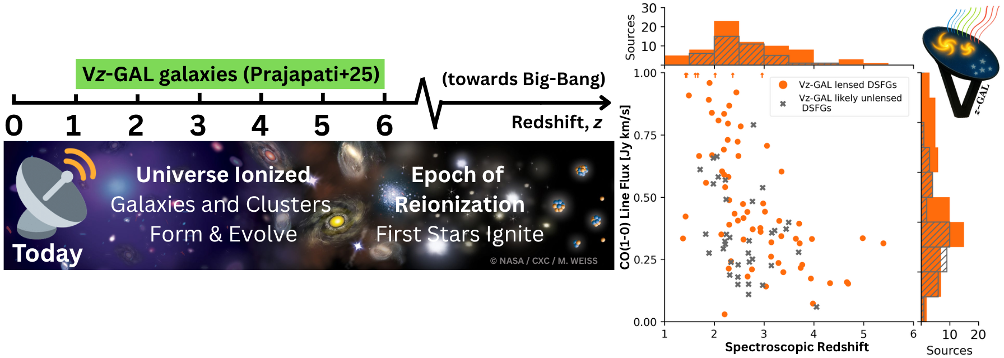Infrared- or submillimeter-bright dusty star-forming galaxies (DSFGs) are key contributors to the cosmic star formation rate density in the early universe, preserving the imprint of its star formation history [1-2]. We are at the forefront of observations, having secured spectroscopic redshifts for about 400 DSFGs up to redshift z ~ 7. Among these, the NOEMA z-GAL is the largest sample of 135 meaningfully selected high-z DSFGs (S500µm > 80 mJy) from the Herschel fields, whose spectroscopic redshifts are robustly measured mainly using higher-J CO lines [3].
In our recent work focused on Vz-GAL, a large program using NSF’s Very Large Array (VLA), we have focused on investigating galaxy evolution by characterizing the cold gas, fuel for star formation, in 106/135 z-GAL galaxies spanning from the epoch of reionization (redshift z ~ 6, approximately 1 Gyr after the Big Bang) to the post-cosmic noon era (z ~ 1, roughly halfway through the universe’s current age). Vz-GAL targets faint CO(1-0) transition in these high-z galaxies, which is essential for accurately probing cold molecular gas and constraining gas excitation conditions, despite the observational challenges involved. Using Vz-GAL, we double the currently available CO(1-0) measurements at high-zand robustly calibrate gas masses for this homogeneously selected, flux-limited, large statistical sample.
Our analysis compares integrated CO(1-0) line luminosities (as a gas mass proxy) with total infrared luminosities (as an SFR proxy, [4-5]) to explore the Kennicutt-Schmidt correlation and redshift evolution of gas depletion timescales, revealing a galaxy’s evolutionary state. Here we compare our high-z DSFGs to local galaxy populations to understand their physical environments. In addition, rigorously derived CO excitation line ratios yield new insights into the physical state of molecular gas in the early universe. Our preliminary findings regarding gas-to-dust mass ratios and [CI]/CO luminosity ratios further emphasize the necessity for refined radiative transfer modeling fewer ad-hoc assumptions, which can characterize the star-forming interstellar medium via simultaneously fitting the spectral energy distribution of dust and CO line. We find consistent [CI](1-0)/CO(1-0) ratios across redshifts, suggesting the use of [CI](1-0) as an alternative cold gas tracer at z > 1.
We have recently submitted the paper on the Vz-GAL catalog to ApJS. Please find it on the arXiv using https://ui.adsabs.harvard.edu/abs/2025arXiv250925167P/abstract. For more details, please visit https://vzgal.uni-koeln.de.
[1] Madau & Dickinson 2014, ARA&A, 52, 415 [2] Zavala et al. 2021, ApJ, 909, 16 5 [3] Cox et al. 2023, A&A, 678, A27 [4] Ismail et al. 2023, A&A, 678, A27 [5] Berta et al. 2023, A&A, 678, A28.

